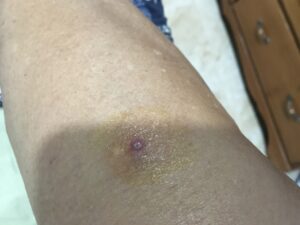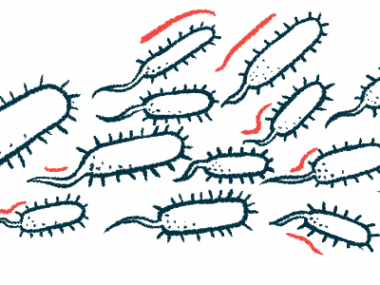A mysterious infection poses an itchy problem for this CAD patient
My weakened immune system and slow healing make treatment challenging
Written by |

I sleepily scratched a bug bite on my arm. It felt a bit different from a mosquito bite — perhaps it was from a red ant or a spider. I rolled over and went back to sleep. That afternoon there was a sore the diameter of a pencil on my arm.
I tried an old-fashioned, tribal treatment. I went to the cupboard, pulled the bin of raw sugar, mounded the bite with as much sugar as I could, and covered it with a Band-Aid. Sometimes it helps and sometimes it doesn’t. This time, it didn’t help.
It’s important to me to have a diagnosis for any kind of infection, as this directs the treatment and path of healing. All of my infections are more significant now that I have an autoimmune, hemolytic anemia called cold agglutinin disease (CAD). Because of that, I thought this sore might be slow to heal.
Even seemingly unrelated infections, like this skin issue, can become a challenge to those of us with CAD. Our red blood cells (RBCs), which carry oxygen and nutrients to other parts of the body, are destroyed by cold agglutinins. There just aren’t enough for a swift recovery. It simply takes longer.
My fight back toward healing
The next day, as I was dressing the original bite, I noticed more pus-filled bumps on my arm. These spots were very itchy. “Was I attacked while I slept by a horde of stealth spiders?” I wondered out loud to myself.
I had no real answers. I could only do my best with the resources at hand. I opened my laptop and put in these search terms: “raised bump, pus-filled, itchy, spreads by touch.” The first time I did that one answer was suggested.
“What is molluscum contagiosum?” I asked.
Molluscum contagiosum is an infection that causes small raised bumps that are very itchy and sometimes filled with pus. It’s common in children but can also be present in adults. I wondered, “What about old women who act like children?”
I read further. According to the U.S. Centers for Disease Control and Prevention (CDC), it isn’t a serious infection and usually heals without the need to go to a clinic. “Oh, good!” said my optimistic self.
Further down the webpage I read that having a compromised immune system, as I do, puts you at greater risk of contracting the disease.
“Jackpot!” I thought. “I’ve hit the lottery of life again.” Still, the CDC webpage made me think that, while the infection may be more serious for “CADdies,” as we who have CAD call ourselves, it would eventually resolve. I imagined scratching my arms and face for the next year. Then I trimmed my fingernails.
I proceeded as if the infection was molluscum. I stopped treating with sugar — especially because it didn’t help. My default strategy when I don’t have confidence in my self-diagnosis is to use treatments at hand and see what happens. So I grabbed a fistful of of Band-Aids, petroleum jelly (to keep the sites moist), and used a lot of soap and water.
It spreads easily and in patches
All this began around Sept. 19. My right arm was so very itchy. But soon, the breakouts spread to my face — I brush hair out of my face — and then to my chest. Everything itched!
I switched to using iodine. Maybe it helped a little bit; maybe the infection was just running its course. I do know things improved slightly. Also, the iodine didn’t sting quite as badly as it did when I was a kid in the 1960s.
I expected this infection to take a long time to resolve. It always does for CADdies. We need healthy RBCs to carry nutrients to the sites of injuries, but since our RBCs are depleted, it just takes more of them to get the job done.
After four weeks, I’d had enough! I resumed my internet searches wondering what else I might have. I found too many possibilities.
My dog, Pokey, noticed my problem. He began paying closer attention to my arms — the infection had spread from my right to my left by now — and face. What did he think this was?
Not finished yet
Finally, after all this time — more than six weeks! — this skin infection is finally healing. I don’t know what caused it, I don’t know what it was, and I don’t know why it is going away.
Oh! Wait! There’s a new lesion on my leg. Here I go again.
Note: Cold Agglutinin Disease News is strictly a news and information website about the disease. It does not provide medical advice, diagnosis, or treatment. This content is not intended to be a substitute for professional medical advice, diagnosis, or treatment. Always seek the advice of your physician or other qualified health provider with any questions you may have regarding a medical condition. Never disregard professional medical advice or delay in seeking it because of something you have read on this website. The opinions expressed in this column are not those of Cold Agglutinin Disease News or its parent company, Bionews, and are intended to spark discussion about issues pertaining to cold agglutinin disease.







Barb Simon💞
You may have been bitten by a recluse spider. If so, you need antibiotics. It could be serious so please see a dr asap.
Mary Lott
This is good advice and I'm grateful. I know it wasn't a recluse as they aren't in Papua, Indonesia. But, there are half-a-jillion other spider types, it could have been any of them. There have been several places on the skin, so a different type of infection is being considered. I am now seeing a doctor about this and following the prescribed treatment.